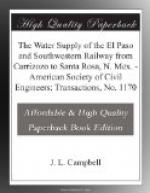Gate-Valves.—In addition to the customary gate-and check-valves at the reservoirs and pumping stations, gate-valves are located at necessary points and elevations in the line to control the flow of water and keep the pipe full, even to the extent of closing all such valves tight and holding the line full without flow. This is for the purpose of delivering through a full pipe any desired quantity of water less than that required to keep the open pipe full. This, of course, is on account of the wood pipe. As the differences of elevations are very great on the gravity sections of the line, and as any one valve might inadvertently become closed tight when other valves above would be open, the bursting of the pipe under such conditions is prevented either by a pressure relief valve attached to and immediately above the gate-valve, or by an open stand-pipe erected on some suitable elevation between the valves. This is more clearly shown on the profile, Plate V, of the ground line and the hydraulic grades of the pipe line. An inspection of this profile will show that these controlling valves are located so that, when closed, the pressure against them does not rise above the maximum pressure on the section above, due to the hydraulic grade of the line when carrying its full capacity.
Safety Valves.—To prevent rupture of the pipe or injury to the pumps, in case the pumping mains should become obstructed, a 6-in. pop safety valve is mounted on the main just beyond the large air-chamber already described. These valves are set to release at the maximum working pressure of the pumps when the regular quantity of water is being pumped, and they are piped to the adjacent reservoir, so that there is no loss from them.
Check-Valves.—Check-valves are placed in the pumping main to prevent the backward flow of water. There is one near the pumps, and one at the upper end and outside of the reservoir into which the main discharges.
Blow-Off Valves.—These valves are located in all material valleys or depressions.
Stand-Pipes.—Between the gate-valves, at certain points where the maximum hydraulic grade is not more than 60 ft. above the surface of the ground, open stand-pipes are erected. If the grade line is too high, relief-valves are used, as stated. Also at two points, where a steep grade ends near the ground surface and is followed by a flatter grade, stand-pipes are erected.
These stand-pipes are of 6-in. iron pipe standing in a special casting in the pipe line and enclosed in a concrete base. They are, of course, open at the top, and vary in height from 15 to 60 ft., depending on the elevation of the hydraulic grade. They have given some checks on the position of this grade during the velocity measurements hereinafter described. Their locations are shown on the profile, Plate V.
Nogal Reservoir.—Nogal Reservoir is the storage unit of the system, and is on the north edge of a table-land, 1,700 ft. above the railway, on the Carrizozo plain, 15 miles away. It is 11-1/2 miles from the head of the pipe on Bonito Creek.




